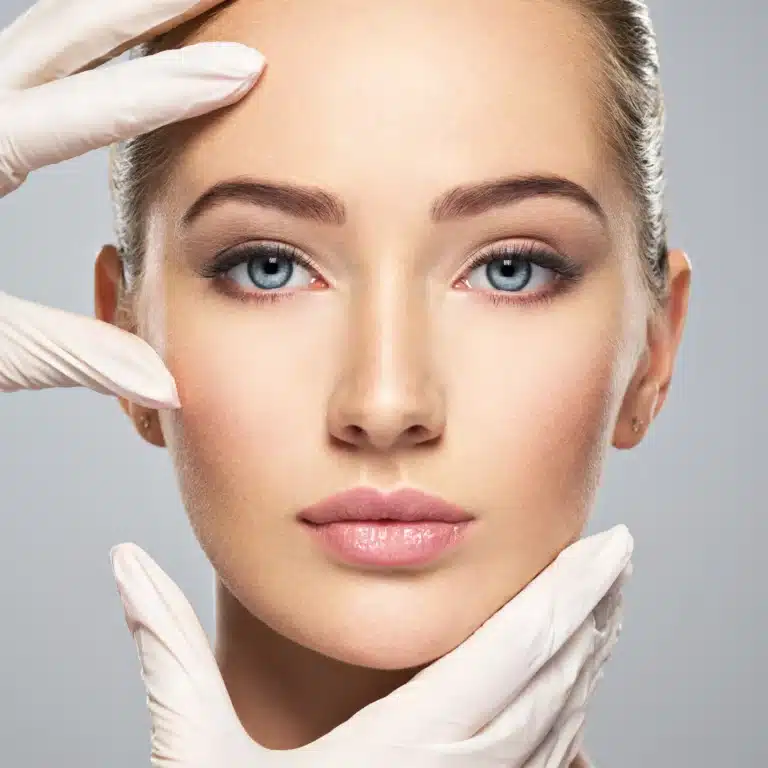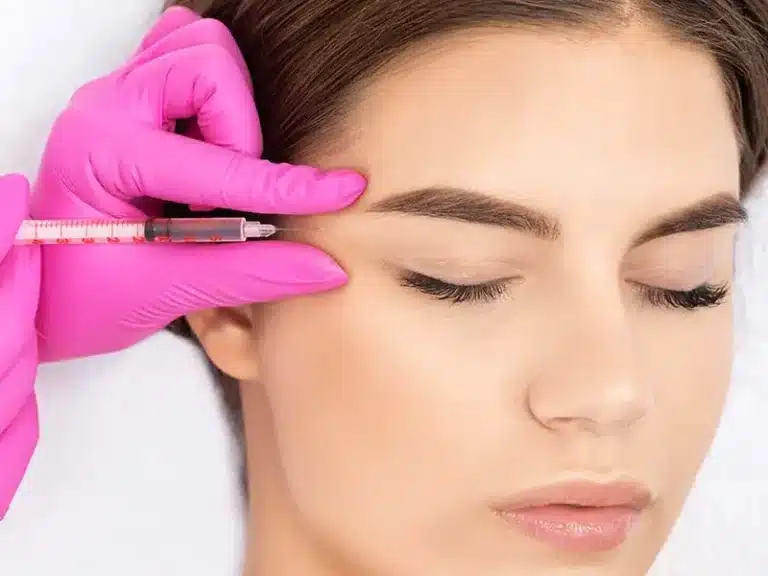Home » Conditions » Face » Temples
The temples are located on either side of the forehead. Anatomically, they are made up of skin, superficial and deep temporal fat, the temporal muscle, and the temporal bone.
This area becomes hollow over time, giving the face a tired and aged appearance.
Hyaluronic acid filler injections can correct this aesthetic concern.
Les tempes sont un élément du tiers supérieur du visage, leur plénitude a un rôle important dans l’équilibre du visage et la vivacité du regard.
Le vieillissement de cette zone est caractérisé par la fonte graisseuse et par l’apparition d’un creux qui donne un air triste et fatigué.
Le comblement des tempes par injection d’acide hyaluronique
redonne une nouvelle jeunesse au visage.
Why inject the temples?
Tout simplement pour lutter contre l’aspect vieilli que créent les tempes creuses et pour traiter ce que l’on appelle la squelettisation du visage : fonte graisseuse qui laisse deviner les contours osseux.

Over the years, three changes affect the temporal area, causing the temples to hollow;
These changes are responsible for four aesthetic concerns :

Hollow temples can be accentuated by :
Le comblement des tempes est une pratique de plus en plus courante, visant à corriger les signes du vieillissement et à restaurer la jeunesse et l’harmonie du visage.
Les injections d’acide hyaluronique sont une traitement efficace pour augmenter le volume des tempes et redessiner leur contour.
L’injection des tempes, comme tout acte médical, doit être réalisée par un médecin expérimenté. En fait, la connaissance de l’anatomie et la maîtrise technique sont essentielles pour éviter les éléments nobles de cette zone : l’artère temporale superficielle et profonde, les veines et le nerf temporal.
It is essential to consult a qualified and experienced doctor to discuss the options best suited to your needs and expectations.
Le comblement des tempes par injection d’acide hyaluronique est destiné aux patient qui souhaitent redonner de la vivacité au regard et restaurer l’harmonie du visage.
The main benefits of the treatment are :
Ce traitement est particulièrement indiqué chez les patients ayant eu une perte de poids importante qui a provoqué une fonte des tissus graisseux au niveau du visage.

The injection ofhyaluronic acid can be done on the surface or at depth. The two techniques can be combined.
L’injection profonde n’est possible qu’au niveau de la partie inférieure de la tempe et le long de la crête temporale.
Le docteur Romano réalise l’injection à l’aiguille et utilise un acide hyaluronique assez ferme. La connaissance parfaite de l’anatomie de la zone est essentielle pour éviter toute complication.
L’injection superficielle se fait à la canule et est réalisée au niveau de la partie externe de la tempe. Le docteur Romano choisit un produit très volumateur ou moyennement volumateur en fonction de la qualité de la peau, des antécédents de lifting temporal ou du visage, de l’importance du volume à restaurer.
Once again, technical mastery is essential, especially if you have a history of facelifts.
Une injection ratée cause des boules visibles en surface ou un surplus de produit qui crée des irrégularités qui s’accentuent au sourire.
L’ acide hyaluronique utilisé a une densité élevée, ce qui permet de combler la perte de volume sans risque de déplacement et donne des résultats durables.

L’injection de Sculptra in the temples is an increasingly popular technique, very much in vogue in the USA and Brazil.
Used to restore volume to the face, Sculptra, or poly-lactic acid, is a non-permanent, biocompatible and biodegradable injectable that stimulates collagen synthesis.
Un seul flacon de produit est employé le jour de l’injection, une deuxième séance est parfois nécessaire trois mois plus tard.
Après les injections, il est normal d’observer un léger gonflement et des rougeurs autour des zones traitées. Ces effets secondaires sont temporaires et disparaissent dans les jours suivants.
Le résultat dure deux ans et est visible trois mois après la séance, car le produit stimule progressivement la production de collagène, ce qui est intéressant pour les personnes qui souhaitent une solution de longue durée.
Le remplissage des tempes très creuses n’est pas une bonne indication, en fait trop de produit serait nécessaire.
C’est pour cela que le docteur Romano conseille de démarrer les injections de Sculptra alentours de la trentaine, quand les premiers signes du vieillissement du visage apparaissent.
Hyaluronic acid injections deliver immediate results that last approximately one year.
Filling the hollow eliminates the shadow in the temple area and the bone is no longer visible, thus addressing facial skeletonization.
The face looks rejuvenated, its curves are restored, creating a softer appearance.
The gaze is refreshed and the tail of the eyebrow is subtly lifted.
After-effects are mild. Possible side effects include : a small, temporary bruise, minimal swelling.
If a deep injection is performed, the patient may feel a sensation of pressure in the temple and discomfort when chewing for two or three days.
If a superficial injection is performed, barely visible surface irregularities may persist for a few days.
Le comblement des tempes permet de corriger un creusement souvent lié au vieillissement.
Deux produits sont couramment utilisés pour cette indication : l’acide hyaluronique et le Sculptra.
Le prix d’une injection d’acide hyaluronique pour les tempes est de 600 CHF la seringue. Le nombre de seringues nécessaires peut varier entre 1 et 5. Le résultat est immédiat.
Le Sculptra, injecté plus en profondeur, stimule la production de collagène et son effet est progressif. Le tarif d’un flacon de Sculptra pour les tempes est de 900 CHF. Un seul flacon est utilisé pour les deux tempes.
Le coût total du traitement des tempes dépend du produit choisi et du volume nécessaire, évalué lors de la consultation initiale.
The frequency of renewal depends on the type of product used and the patient's metabolism. In general, one session per year or every two years is sufficient to maintain results.
La perte de volume des tempes est une modification liée à l’âge caractérisée par un creusement de la région des tempes ce qui donne un aspect fatigué et vieilli au visage.
Treatments are painless. Patients generally experience slight discomfort rather than real pain.
Les résultats des injections d’acide hyaluronique durent généralement entre neuf et douze mois, ceux des injections de Sculptra durent environ deux ans. La durée exacte dépend de plusieurs facteurs, notamment le métabolisme du patient et le produit utilisé.
Oui, lorsque les traitements sont réalisés par un médecin formé et expérimenté, ils sont sûrs. Il est important de choisir un médecin expérimenté pour éviter les complications.
Le choix du traitement dépend de plusieurs facteurs : l’étendue de la perte de volume, les attentes du patient, la qualité de la peau et la morphologie du visage. Une consultation avec un médecin permettra de déterminer le traitement le plus adapté.
For non-surgical treatments such as fillers, the effects are reversible. Hyaluronic acid can be dissolved with a specific enzyme if necessary. After surgery such as a temporal lift, the results are permanent, although the natural ageing process continues.
The treatment of hollow temples restores lost volume, harmonises facial contours and gives a more youthful, rested appearance.
Les traitements sont médicaux : injection d’acide hyaluronique, de Sculptra, de Radiesse ou chirurgicaux : injection de graisse autologue (lipofilling).
Side effects include redness, bruising and slight swelling. These effects are temporary and disappear within a few days.
Les contre-indications sont la grossesse, l’allaitement, certaines maladies auto-immunes et l’allergie à la lidocaïne. Une consultation préalable est nécessaire pour évaluer l’éligibilité de chaque patient.
Après le traitement, il est recommandé d’éviter les activités physiques intenses, les saunas et les bains de vapeur pendant quelques jours. Il est également conseillé d’éviter de toucher ou de masser la zone traitée pour prévenir tout déplacement du produit.
Oui, le traitement des tempes peut être combiné avec d’autres procédures esthétiques, telles que les injections de comblement pour les joues ou les lèvres, les injections de toxine botulique et d’autres techniques de rajeunissement facial. Cela donne un résultat global harmonieux.